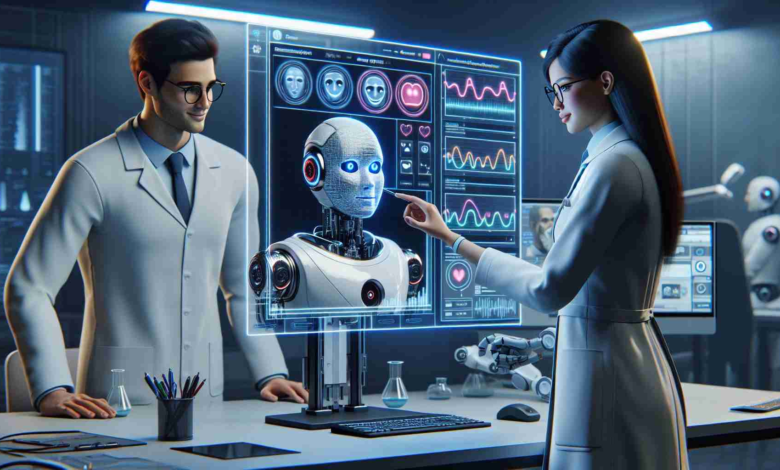Revolutionizing Human-Robot Interactions with Emotive Robotic Technology

Summary: A revolutionary robotic face named Emo has been developed, demonstrating unparalleled expressiveness among robots, which could change the way humans interact with machines. Emo’s dual neural networks analyze human emotions and replicate them, enhancing its emotional vocabulary and aiming to create seamless human-robot exchanges. This innovation may significantly affect various industries, though it also raises ethical considerations and challenges for the future development of social robotics.
In the evolving landscape of artificial intelligence, a transformational innovation is paving the way for a new era of human-robot interactions. Researchers have introduced Emo, an advanced robotic face equipped with camera eyes and a series of motors beneath its synthetic skin, which allow it to exhibit a broad spectrum of human-like expressions. Unlike its predecessors, Emo doesn’t just imitate; it learns from watching human expressions and refines its mimicking capabilities through live camera feedback, similar to how people practice facial expressions in a mirror.
Emo’s dual neural network design is not solely about imitation; it aspires to interact emotively, responding to human dialogue with appropriate facial expressions. The project, led by Professor Hod Lipson, has ambitious goals of making interactions with robots more natural and emotionally engaging. As technology progresses, these interactions could become as common and meaningful as those between humans.
The potential applications for Emo and similar robotic systems are vast, from customer service to therapeutic support. Market analysts forecast robust growth in the social robots sector, driven by these advancements in AI and robotics, alongside the decreasing costs of manufacturing components.
However, the development of emotionally intelligent robots presents unique challenges, including ethical considerations and the potential displacement of jobs traditionally held by humans. Developers like Professor Lipson are mindful of these issues, aiming to balance technological innovation with social responsibility.
As expressive robotics technology matures, it is expected to blend more seamlessly into the fabric of society, provided developers navigate ethical dilemmas and deliver meaningful interactions. For further insight into the progress of AI and robotics, enthusiasts can delve into resources from leading research organizations and follow discussions on ethical AI practices.
A New Frontier in AI: Emo’s Robotic Expressiveness
As we forge deeper into the 21st century, artificial intelligence (AI) and robotics continue to make inroads into various aspects of our lives. At the forefront of this technological renaissance is Emo, a groundbreaking robotic marvel that boasts a level of expressiveness previously unseen in machines. Emo’s development heralds an exciting phase in the industry that could revolutionize how we perceive and interact with robots.
The Breakthrough of Emo
Emo’s lifelike behavior stems from its ability to decode and replicate human emotions with a high degree of precision. Through sophisticated dual neural networks, this robotic face discerns emotional cues from human interactions and responds with appropriate facial expressions, thus advancing the realm of social robotics. Professor Hod Lipson and his team’s objective is to blur the lines between human-human and human-robot interactions, aspiring towards a synergy that feels more intuitive and emotionally resonant.
Industry Implications and Market Growth
The innovation that Emo embodies has the potential to impact a spectrum of industries, igniting progress in customer service, health care, psychological therapy, and companionship for the elderly and individuals with special needs. Reflecting the rising trend, market forecasts anticipate a significant surge in the social robot domain, where Emo-like robots may become integral to numerous service-oriented sectors.
One of the main drivers of this growth is increased accessibility, attributed to the declining costs of high-tech manufacturing and the scalability of AI technologies. As a result, businesses are increasingly looking to integrate such emotionally intelligent systems into their operations to improve efficiency and customer satisfaction.
Ethical Considerations and Societal Impact
Nonetheless, such advancements do not come without potential repercussions. The advent of Emo raises important ethical questions regarding the nature of human-robot relationships, privacy, emotional manipulation, and the potential for reduced human contact. Moreover, the displacement of jobs due to robotic automation continues to be a critical discussion point, necessitating careful contemplation of the socioeconomic implications.
In recognizing these challenges, pioneers like Professor Lipson highlight the need for a responsible approach towards the advancement of social robots, ensuring that these systems serve to enhance human life rather than detract from it.
As this industry evolves, ongoing research and development are vital to the successful and ethical integration of robots like Emo into society. Enthusiasts and professionals alike may explore a wealth of information from established research bodies and platforms dedicated to AI and robotics, fostering a well-informed community aware of the latest developments and ethical considerations.
For those interested in the broader context of AI and robotics, I recommend visiting authoritative sources such as the IEEE, which offers extensive resources and insights into current trends and future directions in technology. Another essential hub for debates and guidelines on ethical AI is the Association for Computing Machinery (ACM). These platforms can further enrich the conversation around emerging technologies like Emo and their role in shaping tomorrow’s world.

Jerzy Lewandowski, a visionary in the realm of virtual reality and augmented reality technologies, has made significant contributions to the field with his pioneering research and innovative designs. His work primarily focuses on enhancing user experience and interaction within virtual environments, pushing the boundaries of immersive technology. Lewandowski’s groundbreaking projects have gained recognition for their ability to merge the digital and physical worlds, offering new possibilities in gaming, education, and professional training. His expertise and forward-thinking approach mark him as a key influencer in shaping the future of virtual and augmented reality applications.



